2025婵°倗濮烽崑鐔烘崲濠靛鍤堥柟杈剧畱閻愬﹤霉閻樺樊鍎岄柡浣割儔閺岋綁骞樺Δ鈧Λ宀勫磻閹捐绀冩い鎾跺У绗戦梻浣稿悑濡叉帞鍒掓ィ鍐炬晪闁靛繈鍨婚惌鎾绘煙鐎电ǹ校缂佹劖顨呴埥澶愬箻椤栨矮澹曢梻渚€娼уΛ鏃堟嚄閸洩缍栭柡宥庡幗閸庡孩銇勯弬鍨倯缁炬崘妫勮灋闁绘鐓鍡氬С闂侇剙绉寸€氬鈹戞径瀣潷F闂備胶绮〃鍛存偋閻愬灚顫曟繝闈涱儏绾偓闂佸搫顦悘婵嬫偂閺囩偐妲堥柡鍐╂崌濡绢喗绻濋埀顒佸鐎涙ɑ娅栭柣蹇曞仦閸庢娊路娓氣偓閺岋繝宕奸敐鍡╀哗婵犫拃鍕垫晿PP闂備焦瀵х粙鎴︽偋婵犲偊鑰垮〒姘e亾鐎规洘鍨甸~婵囷紣濠靛洦鐦滅紓鍌氬€风粈渚€宕埡鍐ㄥК闁告洦鍨遍弲顒勬倶閻愬吀绱╁〒姘e亾妤犵偛绻橀幃銏ゆ倻閳轰椒澹曢梺鍛婂姦閸樻儳危閹间焦鐓曢柡鍐ㄥ€搁弸娆撴煕韫囨棑鑰块柡浣哥У瀵板嫬鈽夊槌栨Х闂備礁鎲¢崵搴ㄥ礉韫囨侗鏁嬫俊銈呮噹缁狅綁鏌″搴″闁哄濮撮埥澶愬籍閳ь剚鍒婃禒瀣垫晪妞ゆ帒瀚粈澶愭煟濡じ鍚柣鐔告崌濮婂宕煎☉妯间紕濠电偛鐗婇崹鐢割敋閵夆晩鏁婇悹浣哥-缁犳岸姊洪幐搴″枙闁瑰嚖鎷�

PDF闂備胶绮〃鍛存偋婵犲洤鏄ラ柛娑欐綑閻愬﹪鏌熼幆褎鍣界紒鎰舵嫹

濠电偞鍨跺Λ鎴︽⒔閸曨偓鑰垮ù鍏兼綑缁狅絾銇勮箛鎾愁仾缂佸倸鐗撻弻銊モ槈閾忣偄顏�

闂備礁缍婂ḿ褔顢栭崱妞绘敠闁逞呭締PP闂備浇顫夐幆灞剧濠婂厾鐟邦潨閳ь剟寮澶嬫櫢闁跨噦鎷�
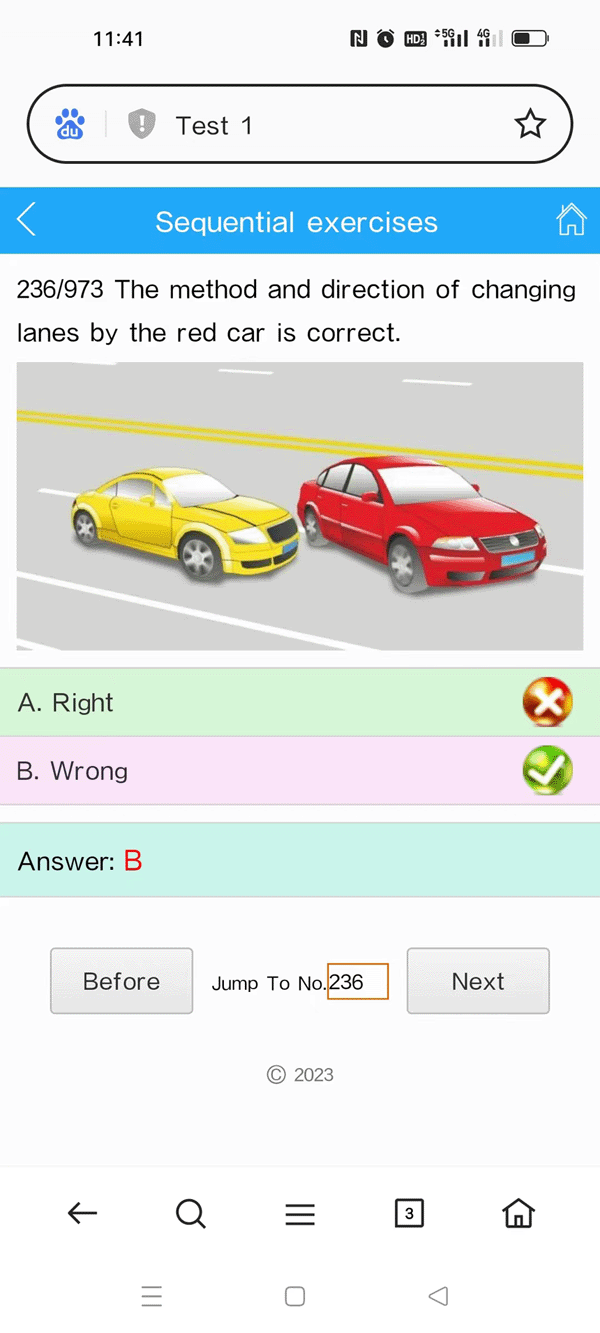
1. When running on an expressway that has four lanes in the same direction, the vehicles whose speed is higher than 110 kilometers per hour should run ______.
A. The far left lane
B. The second left lane
C. The far right lane
D. The third left lane
Answer:A
2. What marking is the two white broken lines in the circle?
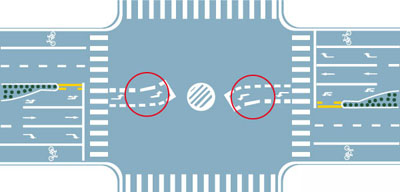
A. stop lines at crossroad
B. left-turn waiting areas
C. U turn guide lines
D. small vehicles turning lines
Answer:B
3. It lights to indicate that engine compartment is opened.

A. Right
B. Wrong
Answer:B
4. Whats the meaning of the yellow marking on the road?
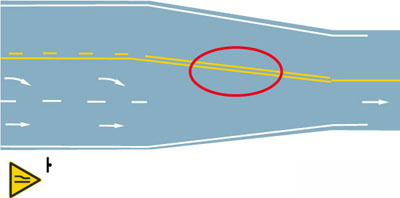
A. gradual road width
B. more carriageways
C. closing to obstacle
D. construction section indication
Answer:A
5. This sign warns the driver there have traffic lights ahead.
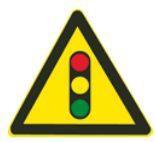
A. Right
B. Wrong
Answer:A
6. When driving a vehicle through an inundated road with pedestrians on both sides, the driver should ________.
A. Speed up and pass
B. Go forward normally
C. Continuously honk
D. Reduce speed and go slowly
Answer:D
7. When a vehicle runs on an expressway, the driver may ascertain the speed according to his feeling.
A. Right
B. Wrong
Answer:B
8. This sign reminds overflowing road or overflowing bridge ahead.

A. Right
B. Wrong
Answer:A
9. Driving a small passenger vehicle on the expressway, the minimum speed should not be less than 90 kilometers per hour.
A. Right
B. Wrong
Answer:B
10. As thick fog reduces visibility, turning on the high beam light can increase the visibility.
A. Right
B. Wrong
Answer:B
11. A driver should drive the vehicles in accordance with the qualification listed on the driving license.
A. Right
B. Wrong
Answer:A
12. The main impact of the road conditions in icy and snowy weather is ______.
A. The electric equipment can easily get wet and cause short circuit
B. The visibility is lower and the field of vision is blurred
C. The resistance to the vehicle increases
D. Poor braking performance and Side pulling
Answer:D
13. If a motorized vehicle hits a building or a public facility, the vehicle may leave the scene right away.
A. Right
B. Wrong
Answer:B
14. When the green arrow for a lane is on and there are still pedestrians in the crosswalk before the vehicle, the driver should ___________.
A. Directly start up and pass
B. Start up and bypass the pedestrians from behind
C. Start up and bypass before the pedestrians
D. Start up after the pedestrians have passed
Answer:D
15. A vehicle is not allowed to reverse on the ramp of an expressway.
A. Right
B. Wrong
Answer:A
16. ABS system can maximize the braking efficiency when conducting _______
A. braking intermittently
B. braking continuously
C. applying emergency braking
D. gently depressing the brake pedal
Answer:C
17. When a driver drives a motorized vehicle during the period of probation, the driver should paste or hang a uniform probation mark on the rear part of the vehicle.
A. Right
B. Wrong
Answer:A
18. If a driver has driven a motorized vehicle for more than four hours running, he should stop the vehicle and rest for at least ____________.
A. 10 minutes
B. 15 minutes
C. 20 minutes
D. 5 minutes
Answer:C
19. When a motorized vehicle runs in a foggy weather, the driver should turn on the fog light and the hazard lights.
A. Right
B. Wrong
Answer:A
20. When a vehicle goes uphill, the driver should observe the road conditions and the length of the slope in advance and shift to the lower gear in a timely manner to ensure the vehicle has sufficient power.
A. Right
B. Wrong
Answer:A
21. This sign reminds a sharp curve ahead.
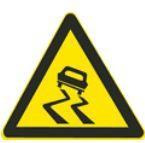
A. Right
B. Wrong
Answer:B
22. Speed up when passing the overflowing road.
A. Right
B. Wrong
Answer:B
23. Whats the meaning of this sign?
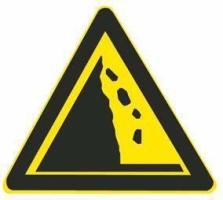
A. dangerous hillside road
B. cliff section
C. watch for dropping stone
D. dangerous section
Answer:C
24. A motorized vehicle driver who uses other motorized vehicles license plate and vehicle license is subject to a 3-point penalty.
A. Right
B. Wrong
Answer:B
25. What is the max speed when passing this curve?

A. 40km/hr
B. 30km/hr
C. 50km/hr
D. 70km/hr
Answer:B




